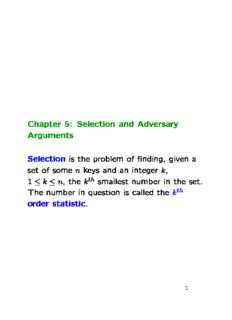
Chapter 5: Selection and Adversary Arguments Selection is the problem of finding, given a set of ... PDF
Preview Chapter 5: Selection and Adversary Arguments Selection is the problem of finding, given a set of ...
Chapter 5: Selection and Adversary Arguments Selection is the problem of flnding, given a set of some n keys and an integer k, th 1 • k • n, the k smallest number in the set. th The number in question is called the k order statistic. 1 1. Finding the Maximum To flnd the maximum of n keys using key comparison, n ¡ 1 comparisons are necessary and su–cient. The reason is that a number is known to be the maximum only if everyone else is lost at least once. So, there have to be at least n ¡ 1 comparisons. A same argument holds for the minimum. 2 Finding both the Maximum and the Minimum Theorem A To flnd both the maximum and the minimum of n keys using key comparison, 3n=2 ¡ 2 key comparisons are necessary and su–cient. Su–ciency Consider the following strategy that deals with the input numbers in pairs: † Take the flrst pair, (x; y). Compare x and y; Set A to the larger and B to the other. † For each remaining pair, (x; y), compare x and y; set u to the larger and v to the smaller; set A to the larger of u and A; set B to the larger of v and B. † If one key remains, compare it with A and B. The number of comparisons is d3n=2e ¡ 2. 3 Necessity We will show that for each algorithm that makes less than 3n=2 ¡ 2 key comparisons, there is an input for which the algorithm either fails to compute the maximum or fails to compute the minimum. 4 Adversary Argument To prove this we will use what is called an adversary argument. An adversary is an opponent that a key-comparison algorithm plays against. Its ultimate goal is to maximize the number of key comparisons that the algorithm makes while constructing an input to the problem. At the beginning there is no restriction on the input, but when the algorithm asks about a pair (a; b) of keys the adversary must return either a < b or a > b, then only the inputs that are inconsistent with the answer will be removed from further consideration. 5 Assumptions We assume the following: † The keys are pairwise distinct. † The algorithm cannot remember an key. † At any point during computation, the algorithm can infer > or < based on the outcomes of the comparisons that have been made so far, and the adversary’s answers should never contradict them. 6 Graph Representation The outcomes of the comparisons that have been made so far can be viewed as a directed graph, where the nodes represent the keys and the arcs represent the outcomes. We draw an arc from a node u to a node v if the algorithm has asked about the pair (u; v) and the strategy has provided an answer u < v. A relation a < b is inferred from the previous outcomes if and only if there is a path from a to b. Also, the graph has no cycles. 7 Example The comparisons that have been made are u < v, v < w, and z < w. It can be inferred that u < w. So, when asked about the pair (u; w), the strategy must answer u < w. u v w z 8 Stopping Condition The algorithm stops examination when the graph acquires a certain property. For computing the maximum and the minimum, the stopping condition is when † there is a node from which all the other nodes are reachable (thus, it’s the minimum), and † there is a node to which all the other nodes are reachable (thus, it’s the maximum). Since there is no cycle, when the stopping condition holds, † each of the other two nodes has at least one incoming edge and at least one outgoing edge. 9 u w v maximum minimum other nodes n−2 of this kind 10
Description: